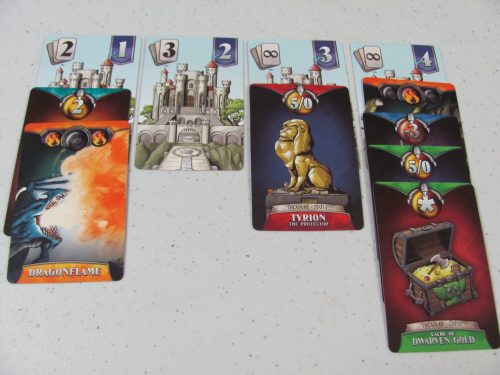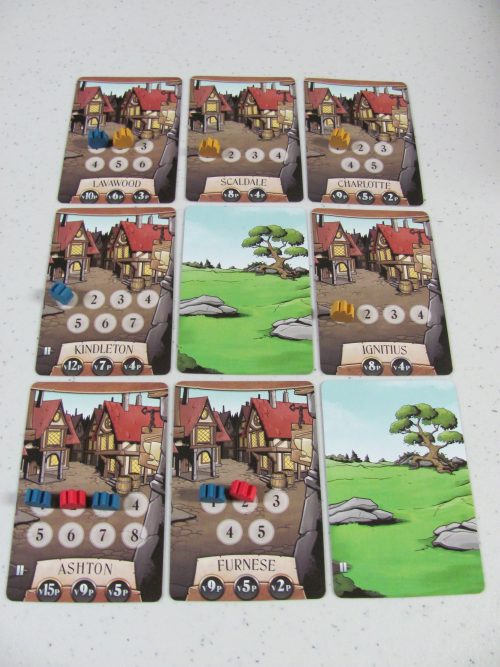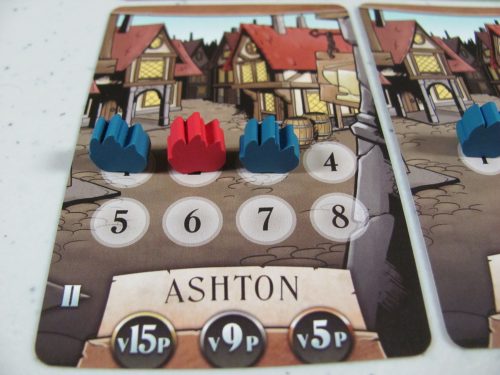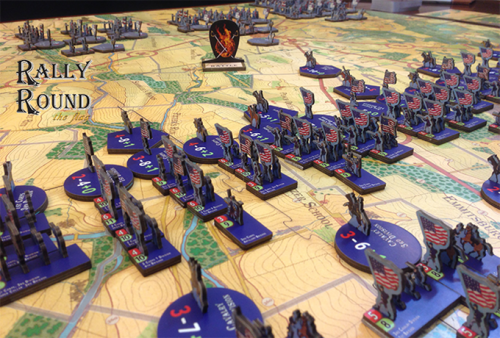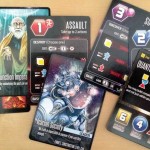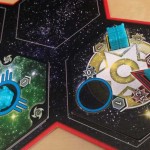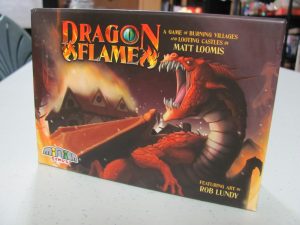 While Robert has us on the subject of dragons, let’s talk about Minion Games’ Dragon Flame. Similar in theme to Wrath of Dragons—you play the rampaging wyrms—Dragon Flame, though, presents a lighter but still strategically satisfying experience.
While Robert has us on the subject of dragons, let’s talk about Minion Games’ Dragon Flame. Similar in theme to Wrath of Dragons—you play the rampaging wyrms—Dragon Flame, though, presents a lighter but still strategically satisfying experience.
The first part of Dragon Flame has players seeding castles with treasures, one-at-a-time placing treasure cards on the central castles in combinations that they hope will maximize the value of the castle stacks for themselves and minimize their value for the other players. Some of the castles are limited in the number of treasure cards they can take. And depending on what a player accomplished on the previous turn, some number of the treasure cards they play will have to be face-up or face-down.
The second part of the game sees the players acting their parts as dragons, taking turns to attack a castle and grab the treasure cards there. Each type of treasure in a dragon’s hoard at the end of the game scores glory points in a different fashion. For example, jewelry cards are worth a straight number. Statues are worth five points each but only if there are no duplicates. Chests are each worth one point per chest of the same type (thus, their value increases quickly), but this only applies to the single greatest collection of chests. Each chest of another type in a dragon’s hoard results in a penalty of one point.
Dragonflame cards are special. Any in a player’s selected stack gives them a run at burning villages. For every icon on the cards, they can place a flame token on one of a set of village cards. At the end of the game, the dragon who’s contributed the most to burning down a village scores its points.
For me, Dragon Flame’s fun comes from quick but strategic play with a fair amount of back-and-forth positioning player against player. Also, though there may not be dragon meeples, it does come with wood fire tokens to light up pesky human villages.
A complimentary copy of Dragon Flame was provided by Minion Games for review.
- Comments Off on Second Look—Dragon Flame
 Perspective and Sun, Moon & Stars are two micrograms from Minion Games. The former contains only 27 cards, while the latter has just 18. Don’t let the card numbers fool you. Both of them are meatier than your usual micro game fair, and I have to say I was surprised by the experience from both.
Perspective and Sun, Moon & Stars are two micrograms from Minion Games. The former contains only 27 cards, while the latter has just 18. Don’t let the card numbers fool you. Both of them are meatier than your usual micro game fair, and I have to say I was surprised by the experience from both.
I’ll start with Perspective, in my mind the more difficult of the two. It’s not hard to learn how to play the game, but the game itself is difficult. At it’s heart, it’s a memory game. You’re given a goal card and have to arrange the cards in the correct order with the correct colors. The only issue is you need to do so using the backs of your cards, which only your opponent can see. Through clever card play you can flip, trade, sort, and reclaim cards in hopes of setting up your hand for a win.
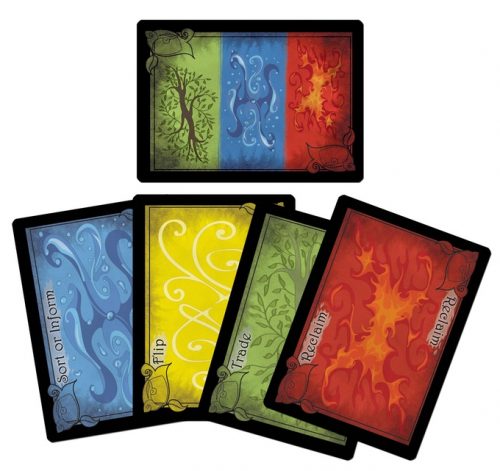
I played Perspective with my 10-year-old, and it took a few tries to get the hang of the game. Once we did, it was a race to see who could memorize what was going on and get their hands in order. Sadly, my tasted victory more than I. We had a great time, even though the game was a bit of a brain burn.
Sun, Moon & Stars is a bit lighter, but my no means less of a game than Perspective. Depending on how many players there are, they are seated North, South, East, and West, and give a goal. Different animals have different victory conditions. Players try to move the sun, moon, and stars around the table so they’ll be in the positions desired by their goal animal. It’s a bit quicker of a play, and puts the players in more direct confrontation that Perspective.
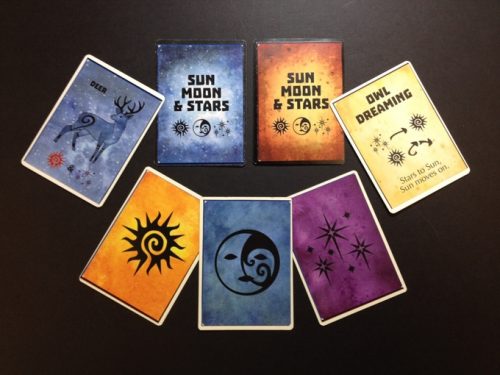 Taking only 5 minutes to play, the game encourages you to play multiple rounds. It’s not hard to do so, as the pleasing aesthetic and, quick play, and satisfying play make it an excellent filler.
Taking only 5 minutes to play, the game encourages you to play multiple rounds. It’s not hard to do so, as the pleasing aesthetic and, quick play, and satisfying play make it an excellent filler.
Both games are available from Minion Games for $9.99 each. Both are worth the price.
Copies of Perspective and Sun, Moon & Stars were provided free for review by Minion Games.
- Comments Off on Second Look—Perspective and Sun, Moon & Stars
Crowdfunding Highlights
21 Jun
Posted by David Miller as Card Games, Modern Board Games, RPGs, War Games
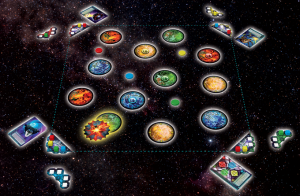 Minion Games’ Cosmic Kaboom is an unusual combination of dexterity and resource collection in a strategic space game. Players flick their space ship discs around the table, collect colored cubes by hitting particular planets, spend sets of cubes to get the space bomb, and then throw the bomb token to blow up planets and collect victory points.
Minion Games’ Cosmic Kaboom is an unusual combination of dexterity and resource collection in a strategic space game. Players flick their space ship discs around the table, collect colored cubes by hitting particular planets, spend sets of cubes to get the space bomb, and then throw the bomb token to blow up planets and collect victory points.
Another game with a tossing element is Monstrous. In this one, the players are angry Greek gods, hurling monsters down from the heavens. The monsters (for example, Gorgon, Phoenix, and Hellhound) are represented by cards, which manifest various powers when hitting location cards or other monsters on the table. Location cards (for example, Delphi, Thebes, and The Underworld) provide victory points when hit but may also implicate the cards in a players hand, bonuses at the end of the game, or some other special rule.
The designers behind Hyde promise a live-action, horror-themed, bio-activated, puzzle maze. As players work their way through a maze of rooms in an imagined laboratory, they’re trying to solve a mystery of human experiments gone wrong. But what really makes this game special is how bio-sensors worn by the players are integrated with various controls around the maze. Among the typical escape-room puzzles are doors, lights, locks, and motors actuated by players’ breathing, heart rate, posture, and other factors. A control program also tracks players in the maze and will adjust the unfolding story depending on their progress.
With the Legendary Planet Adventure Path Legendary Games aims to create a science-fantasy meta-setting for the Pathfinder Roleplaying Game. In other words, it’s background material and a series of adventures with a science-fiction flair but specifically designed as a tie-in to home fantasy campaigns. The first installment sees the player characters escaping from prison using an interdimensional portal.
Rally Round the Flag from Lost Battalion Games is a card-driven war game about the Battle of Gettysburg. The game includes amazing card art, standees instead of generic counters, and a deep level of historic detail. It can be played at the division, brigade, or regiment level, with game stats customized to the individual regiments based on historic research.
Tackling the business of art is The Gallerist from publisher Eagle and Gryphon Games and designer Vital Lacerda. It’s a large, complex strategy game in which the players buy and sell art, as well as promote and manage their galleries. Individual works of art are featured—paintings, sculptures, photography, and digital art.
- Comments Off on Crowdfunding Highlights
Crowdfunding Highlights
07 Sep
Posted by David Miller as Card Games, Modern Board Games, RPGs, War Games
Dead Men Tell No Tales, Minion Games’ 14th Kickstarter project, is a pirate-themed cooperative game in which players explore an on-fire, undead guarded, sinking ship. But why, you ask? Well, for treasure of course! The game has an interesting fatigue mechanic, and also allows players to share with others their unused actions.
Applying the 13th Age roleplaying system to the classic setting of Glorantha is the goal of 13th Age in Glorantha. With new classes, monsters, and icon relationships, designers Rob Heinsoo and Jonathan Tweet look to focus on what they call “myth-crawling”.
While not the first to crowdfund metal coins for games, Coins for Anything is offering an array of alternate designs at a reasonable price. The are Egyptian, Greek, dragon, fire, magic, Viking, Roman, and pirate sets.
From designer Philip duBarry and publisher Game Salute, Skyway Robbery is a steampunk-styled adventure game where the players are criminals traveling the world on an airship, each stop presenting a new opportunity for theft. After recruiting gangs and collecting the tools needed to grab loot, the winner is the player to have accumulated the most criminal renown.
Ignore the lumberjack pig art if you can, Hogger Logger is a game about trying to guess whether one’s face-down cards are higher or lower than the face-up one. Seems simple enough until you realize that other players can change the cards in play at any time simply by replacing them with cards from their hands or by playing action cards for more chaotic manipulations.
1750: Britain vs. France is a historically based card and dice game that includes political, diplomatic, and economic elements in addition to combat.
Play as a child’s toys fighting off nightmares in the card game, Nightlight. The game is cooperative, includes multiple scenarios, and features an interesting mix of cute and dark art.
- Comments Off on Crowdfunding Highlights
 Wow. Hegemonic.
Wow. Hegemonic.
Lots and lots of plastic bits. Lots of cards, but not too overwhelming. Try to take over a galaxy built out of hexes in a big meaty game that isn’t Eclipse, but that’s probably what most people (like me, for instance) are going to compare this to.
Let’s back up.
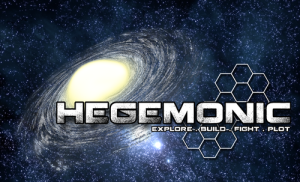
Minion Games’ Hegemonic is a 4X boardgame, which comes from the computer game world: players explore, expand, exploit, and exterminate their way to victory. (Hegemonic rebrands these to “Explore, Build, Fight, and Plot”.) Each player is part of a faction that is expanding its influence across the galaxy: building industrial, political, and military bases in different sectors of the galaxy. Your strong level three military outpost can have its presence felt up to two sectors away, while your opponent’s industrial base can only influence neighboring tiles.
The important part about Hegemonic is how conflicts between players work out. And you’re going to come into conflict. (Remember Eclipse? You can have a nice, friendly, non-conflicty game of Eclipse, and everything is good and fun. Here I suppose you could, but a game of Hegemonic Competitive Solo Fun is not as interesting as a game of Who’s More Efficient at Eclipse?) Conflict: determining the victor in any attack is based on the influence that your forces can muster. Send your secret agent in to sabotage a military base? Add 007’s power to that of all the alien embassies you have set up with Generic Green Alien Race. Does that beat the military outpost’s power and the power of any other military base that could reach it in time? You’ll need to leverage and grow your stellar empire, manipulating various bases to make your attacks on the others more powerful and defend yourself against theirs.
More good stuff: The player boards provide a ton of information and have a clever way of revealing different aspects of managing your galactic empire. Hegemonic scales nicely from two players on up (and the two-player game seems more satisfying than Eclipse’s). The leader cards add flavor to your growing empire, distinguishing them and adding replayability. Deep strategy in getting that balance right in your empire. You could kill someone by dropping the box on their head (arguably “not good”).
Rules for a learning game are included, and you really should play through a learning game to grasp the concepts of Hegemonic.
However…
The plastic Martial Outposts are difficult to pick up in a way that is so annoying that it is worth mentioning to prospective players. The board is ugly, which is strange because the layout of the book, player boards, and cards are really well done. The conflict system as written in the book is more complex than it is in practice. Additionally, it felt like the conflict system tried to be different based on what was attacking what, but it all still felt like the same thing wearing different clothes.
Because of that last issue, I’m having a difficult time recommending Hegemonic over Eclipse. Don’t get me wrong: Hegemonic is a good game that packs in different paths to victory, but the paths feel too alike when compared to Eclipse. (Plus, I love dice and Eclipse’s tech tree/fleet building aspect more than Hegemonic’s technology system.) While meaty, heavy, and well done, Hegemonic won’t hit my table as often as it wants to.
A copy of Hegemonic was provided free for review by Minion Games.
- Comments Off on Second Look—Hegemonic
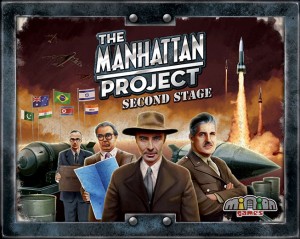 The box for Second Stage includes four smaller expansions to The Manhattan Project. They can be added to the base game individually or all at once.
The box for Second Stage includes four smaller expansions to The Manhattan Project. They can be added to the base game individually or all at once.
- Nations 2 includes seven more countries with unique special abilities.
- Rocket Technology provides an alternative to bombers. Rockets work the same but require rocket factories to build and can’t be countered with fighters.
- H-Bomb Technology doubles the victory points of a plutonium bomb but requires Lithium Deuteride as an additional resource.
- Personalities are roles based on historical characters. They allow flexibility in the placement of workers, free espionage actions, and other benefits.
- Comments Off on The Manhattan Project: Second Stage
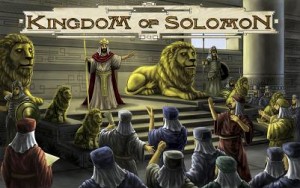 Kingdom of Solomon, from Minion Games and designer Philip duBarry, is a fun strategy board game with a biblical theme. Well, not laugh-out-loud, yell-at-your-friends fun. More like an interesting thinking-game. It’s what hobbyists might call a gamer’s-game, with alternative paths to victory that will take several plays to explore. I like it a lot.
Kingdom of Solomon, from Minion Games and designer Philip duBarry, is a fun strategy board game with a biblical theme. Well, not laugh-out-loud, yell-at-your-friends fun. More like an interesting thinking-game. It’s what hobbyists might call a gamer’s-game, with alternative paths to victory that will take several plays to explore. I like it a lot.
One of the things I like about Kingdom of Solomon is that while it’s definitely a strategy game with a lot going on, it’s also pretty easy to learn and very approachable. The rule book is just a few small pages. The mechanics are, for the most part, not difficult to learn, particularly if you’re a regular Euro-game player. And Fortune Cards add a little bit of luck—just enough to keep me on my toes.
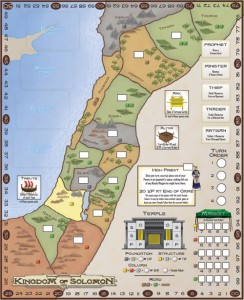 But while Kingdom of Solomon employs several standard Euro-game mechanics, it does so with a twist that’s very interesting. The game is basically a worker-placement game. It even has colored wood cubes to represent resources (gold, stone, food, copper, timber). What’s different is that in this game worker placement means placing pawns to claim territory spaces on the game map. Each space, then, provides one or more specific resources to the player who claimed it (e.g., Amalek yields food, Edom copper, and Gilead stone). Additionally, players have the opportunity to construct buildings in many of the territories, which reserves those spaces for their exclusive use on future turns, and to put down roads between territories, thus making multi-space regions for the more efficient collection of resources.
But while Kingdom of Solomon employs several standard Euro-game mechanics, it does so with a twist that’s very interesting. The game is basically a worker-placement game. It even has colored wood cubes to represent resources (gold, stone, food, copper, timber). What’s different is that in this game worker placement means placing pawns to claim territory spaces on the game map. Each space, then, provides one or more specific resources to the player who claimed it (e.g., Amalek yields food, Edom copper, and Gilead stone). Additionally, players have the opportunity to construct buildings in many of the territories, which reserves those spaces for their exclusive use on future turns, and to put down roads between territories, thus making multi-space regions for the more efficient collection of resources.
That’s not all there is to the game, of course. Pawns can be placed to claim specific roles or actions, such as artisan, trader, minister, and prophet. Or pawns can be placed to claim the ark or altar (though these require all of a player’s remaining pawns at the time of placement). Resources can be bought and sold in the market. Also, the resources are primarily used to build the buildings, which in addition to reserving territories, grant victory points and create personal-use-only spaces for placing pawns. For example, if you build a library (it doesn’t matter which territory is goes in), you put the library card in front of you. Then on future turns you (and only you) can place a pawn there to get Fortune Cards.
Regarding the biblical theme, I feel it worth mentioning that though it thoroughly pervades the game, I didn’t find it an especially religious game. It treats the material like any other historical setting. I believe the designer is Christian. I’m Jewish. I played the game with a group from my synagogue and no one had any difficulty with it.
There are a few small things about Kingdom of Solomon that one could pick on. One is that the explanation of how regions are created and used is a little confusing, especially when you factor in the high priest (a special bonus earned by the player who has contributed the most to construction of the temple). Overall, though, it’s a good, not-too-difficult strategy game with an interesting theme and intriguing game play. If Minion Games hadn’t already given me a copy, I’d buy it. It’s a wise choice.
Trending
- Massdrop.com
- Oh the Irony—Illuminati Card Game Continues to Inspire Conspiracy Theorists
- Home
- Footprints, an Educational Ecology Game
- USPS Adds Board Game Flat Rate Box
- Baila, the Estonian Drinking Card Game
- Crystal Caste Wins Dice Patent Suit Against Hasbro
- Mirror Game, Red and Blue
- Hasbro and Mattel Merger?
- Are Board Games Dangerous?
Archives
Most Popular Articles
- Oh the Irony—Illuminati Card Game Continues to Inspire Conspiracy Theorists
- The 20 Most Valuable Vintage Board Games
- The Truth About Dominoes On Sunday in Alabama
- Sequence Game, and Variants
- USPS Adds Board Game Flat Rate Box
- Baila, the Estonian Drinking Card Game
- The 13 Most Popular Dice Games
- Are Board Games Dangerous?
- Guess Who? The Naked Version
- What Happened to the Jewel Royale Chess Set?
Recent Posts
- Toy Fair 2019—Breaking Games
- Talisman Kingdom Hearts Edition
- Toy Fair 2019—Winning Moves
- Toy Fair 2019—Games Workshop
- Toy Fair 2019—Star Wars Lightsaber Academy
- Toy Fair 2019—Stranger Things Games
- Toy Fair 2019—HABA
- Licensing Roundup
- Game Bandit
- 2018 A Difficult Year For Hasbro But Not For D&D Or MtG
Recent Comments
- on Toy Fair 2019—Winning Moves
- on Game Bandit
- on Second Look—Dungeons & Dragons Waterdeep Dragon Heist
- on Crowdfunding Highlights
- on Beyblade SlingShock
- on Game Bandit
- on Game Bandit
- on Watch This Game!, the Board Game Review Board Game
- on Second Look—Vampire: The Masquerade 5th Edition
- on Palladium Books Loses Robotech IP License, Cancels Five-Year-Overdue Robotech RPG Tactics Kickstarter

